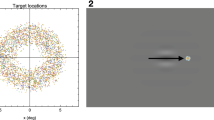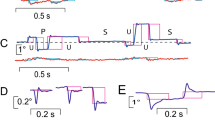Abstract
Primary gaze fixation is never perfectly stable but can be interrupted by involuntary, conjugate saccadic intrusions (SI). SI have a high prevalence in the normal population and are characterised by a horizontal fast eye movement away from the desired eye position, followed, after a variable duration, by a return saccade or drift. Amplitudes are usually below 1° and they often exhibit a directional bias. The aim of the present study was to investigate the aetiology of SI in relation to saccadic behaviour. It was hypothesised that if SI resulted from deficits in the saccadic system (i.e. reduced inhibitory mechanisms), changes in voluntary saccade behaviour may be apparent and related to SI frequency. To examine this, synchrony (no gap), gap, overlap and antisaccade tasks were conducted on ten normal subjects. No significant correlations were found between SI frequency and voluntary saccade latencies, the percentage of express saccades, or the percentage of antisaccade errors. In addition, no significant correlations were found between SI directional biases and saccade latency directional biases, express saccade biases or antisaccade error biases. These results suggest that an underlying alteration to saccadic behaviour is unlikely to be involved in SI production, and that the SI command signal may arise from the influence of attention on an intact saccadic system. Specifically, descending corticofugal signals relating to attention level and orientation may alter the balance between fixation and saccade generation, so determining SI characteristics.




Similar content being viewed by others
References
Abadi RV, Gowen E (2004) Characteristics of saccadic intrusions. Vision Res 44:2675–2690
Amador N, Schlag-Rey M, Schlag J (2004) Primate antisaccade. II. Supplementary eye field neuronal activity predicts correct performance. J Neurophysiol 91:1672–1689
Biscaldi M, Fischer B, Stuhr V (1996) Human express saccade makers are impaired at suppressing visually evoked saccades. J Neurophysiol 76:199–214
Braun D, Weber H, Mergner T, Schulte-Monting J (1992) Saccadic reaction times in patients with frontal and parietal lesions. Brain 115:1359–1386
Carpenter RHS (1988) Miniature eye movements. In: Carpenter RHS (ed) Movements of the eyes. Pion, London, Ch 6, pp 124–138
Coull JT, Frith CD, Buchel C, Nobre AC (2000) Orienting attention in time: behavioural and neuroanatomical distinction between exogenous and endogenous shifts. Neuropsychologia 38:808–819
Dias EC, Bruce CJ (1994) Physiological correlate of fixation disengagement in the primate’s frontal eye field. J Neurophysiol 72:2532–2537
Ditchburn RW (1973) Kinematic description of eye movements. In: Eye movements and visual perception. Clarendon, Oxford, Ch 4, pp 78–107
Dorris MC, Munoz DP (1995) A neural correlate for the gap effect on saccadic reaction times in monkey. J Neurophysiol 73:2558–2562
Dorris MC, Pare M, Munoz DP (1997) Neuronal activity in monkey superior colliculus related to the initiation of saccadic eye movements. J Neurosci 17:8566–8579
Doslak MJ, Dell’Osso LF, Daroff RB (1983) Multiple double saccadic pulses occurring with other saccadic intrusions and oscillations. Neuroophthalmology 3:109–116
Edelman JA, Keller EL (1996) Activity of visuomotor burst neurons in the superior colliculus accompanying express saccades. J Neurophysiol 76:908–926
Engbert R, Kliegl R (2003) Microsaccades uncover the orientation of covert attention. Vision Res 43:1035–1045
Everling S, Munoz DP (2000) Neuronal correlates for preparatory set associated with pro-saccades and anti-saccades in the primate frontal eye field. J Neurosci 20:387–400
Everling S, Dorris MC, Munoz DP (1998a) Reflex suppression in the antisaccade task is dependent on prestimulus neural processes. J Neurophysiol 80:1584–1589
Everling S, Spantekow A, Krappmann P, Flohr H (1998b) Event-related potentials associated with correct and incorrect responses in a cued antisaccade task. Exp Brain Res 118:27–34
Feldon SE, Langston JW (1977) Square wave jerks: a disorder of microsaccades? Neurology 27:278–281
Fischer B, Weber H (1992) Characteristics of “anti” saccades in man. Exp Brain Res 89:415–424
Fischer B, Weber H (1993) Express saccades and visual attention. Behav Brain Sci 16:553–610
Fischer B, Weber H (1997) Effects of stimulus condition on the performance of antisaccades in man. Exp Brain Res 116:191–200
Fischer B, Biscaldi M, Otto P (1993a) Saccadic eye movements of dyslexic adult subjects. Neuropsychologia 31:887–906
Fischer B, Weber H, Biscaldi M, Aiple F, Otto P, Stuhr V (1993b) Separate populations of visually guided saccades in humans: reaction times and amplitudes. Exp Brain Res 92:528–541
Fischer B, Gezeck S, Huber W (1995) The three-loop model: a neural network for the generation of saccadic reaction times. Biol Cybern 72:185–196
Fischer B, Biscaldi M, Gezeck S (1997) On the development of voluntary and reflexive components in human saccade generation. Brain Res 754:285–297
Fischer B, Gezeck S, Hartnegg K (1997) The analysis of saccadic eye movements from gap and overlap paradigms. Brain Res Brain Res Protoc 2:47–52
Friedman HR, Burman DD, Russo GS, Dias EC, Shi D, Stanton DB, Bruce CJ (1997) Neuronal activity in primate frontal eye field during memory guided saccades. Soc Neurosci 23:844
Galfano G, Betta E, Turatto M (2004) Inhibition of return in microsaccades. Exp Brain Res 159:400–404
Gandhi NJ, Keller EL (1999) Comparison of saccades perturbed by stimulation of the rostral superior colliculus, the caudal superior colliculus and the omnipause neuron region. J Neurophysiol 82:3236–3253
Gaymard B, Rivaud S, Pierrot-Deseilligny C (1993) Role of the left and right supplementary motor areas in memory-guided saccade sequences. Ann Neurol 34:404–406
Gaymard B, Ploner CJ, Rivaud-Pechoux S, Pierrot-Deseilligny C (1999) The frontal eye field is involved in spatial short-term memory but not in reflexive saccade inhibition. Exp Brain Res 129:288–301
Gaymard B, Francois C, Ploner CJ, Condy C, Rivaud-Pechoux S (2003) A direct prefrontotectal tract against distractibility in the human brain. Ann Neurol 53:542–545
Gomez C, Atienza M, Vazquez M, Cantero JL (1994) Saccadic reaction times to fully predictive and random visual targets during gap and non-gap paradigms. In: Delgado-Garcia JM, Godaux E, Vidal PP (eds) Information processing underlying gaze control. Pergamon, Oxford, pp 109–115
Guitton D, Buchtel HA, Douglas RM (1985) Frontal lobe lesions in man cause difficulties in suppressing reflexive glances and in generating goal-directed saccades. Exp Brain Res 58:455–472
Hafed ZM, Clark JJ (2002) Microsaccades as an overt measure of covert attention shifts. Vision Res 42:2533–2545
Hikosaka O, Wurtz RH (1985) Modification of saccadic eye movements by GABA-related substances. II. Effects of muscimol in monkey substantia nigra pars reticulata. J Neurophysiol 53:292–308
Honda H (2002) Idiosyncratic left-right asymmetries of saccadic latencies: examination in a gap paradigm. Vision Res 42:1437–1445
Hunt AR, Kingstone A (2003) Covert and overt voluntary attention: linked or independent?. Brain Res Cogn Brain Res 18:102–105
Kastner S, Ungerleider LG (2000) Mechanisms of visual attention in the human cortex. Annu Rev Neurosci 23:315–341
Kingstone A, Klein RM (1993) Visual offsets facilitate saccadic latency: does predisengagement of visuospatial attention mediate this gap effect? J Exp Psychol Hum Percept Perform 19:1251–1265
Kowler E, Anderson E, Dosher B, Blaser E (1995) The role of attention in the programming of saccades. Vision Res 35:1897–1916
Kustov AA, Robinson DA (1996) Shared neural control of attentional shifts and eye movements. Nature 384:74–77
Lasker AG, Zee DS, Hain TC, Folstein SE, Singer HS (1987) Saccades in Huntington’s disease: initiation defects and distractibility. Neurology 37:364–370
Mayfrank L, Mobashery M, Kimmig H, Fischer B (1986) The role of fixation and visual attention in the occurrence of express saccades in man. Eur Arch Psychiatry Neurol Sci 235:269–275
Munoz DP, Wurtz RH (1992) Role of the rostral superior colliculus in active visual fixation and execution of express saccades. J Neurophysiol 67:1000–1002
Munoz DP, Wurtz RH (1993a) Fixation cells in monkey superior colliculus. 1. Characteristics of cell discharge. J Neurophysiol 70:559–575
Munoz DP, Wurtz RH (1993b) Fixation cells in monkey superior colliculus II. Reversible activation and deactivation. J Neurophysiol 70:576–589
Munoz DP, Wurtz RH (1995a) Saccade-related activity in monkey superior colliculus I. Characteristics of burst and buildup cells. J Neurophysiol 73:2313–2333
Munoz DP, Wurtz RH (1995b) Saccade-related activity in monkey superior colliculus II. Spread of activity during saccades. J Neurophysiol 73:2334–2348
Munoz DP, Broughton JR, Goldring JE, Armstong IT (1998) Age-related performance of human subjects on saccadic eye movement tasks. Exp Brain Res 121:391–400
Muri RM, Rivaud S, Gaymard B, Ploner CJ, Vermersch AI, Hess CW, Pierrot-Deseilligny C (1999) Role of the prefrontal cortex in the control of express saccades. A transcranial magnetic stimulation study. Neuropsychologia 37:199–206
Nobre AC, Sebestyen GN, Gitelman DR, Mesulam MM, Frackowiak RSJ, Frith CD (1997) Functional localization of the system for visuospatial attention using positron emission tomography. Brain 120:515–533
Nobre AC, Gitelman DR, Dias EC, Mesulam MM (2000) Covert visual spatial orienting and saccades: overlapping neural systems. Neuroimage 11:210–216
Ohtsuka K, Mukuno K, Ukai K, Ishikawa S (1986) The origin of square wave jerks: conditions of fixation and microsaccades. Jpn J Ophthalmol 30:209–215
Pierrot-Deseilligny C, Rivaud S, Gaymard B, Agid Y (1991) Cortical control of reflexive visually-guided saccades. Brain 114:1473–1485
Pierrot-Deseilligny C, Muri RM, Ploner CJ, Gaymard B, Demeret S, Rivaud-Pechoux S (2003) Decisional role of the dorsolateral prefrontal cortex in ocular motor behaviour. Brain 126:1460–1473
Pierrot-Deseilligny C, Milea D, Muri RM (2004) Eye movement control by the cerebral cortex. Curr Opin Neurol 17:17–25
Posner JB, Walker JA, Friedrich FJ, Rafal R (1984) Effects of parietal injury on covert orienting of attention. J Neurosci 4:1863–1874
Powell KD, Colby CL, Gottlieb J, Kusunoki M, Goldberg ME (1999) Space and salience in parietal cortex. In: Becker W, Deubel H, Mergner T (eds) Current oculomotor research. Physiological and psychological aspects. Kluwer/Plenum, New York, pp 25–35
Rafal R (1999) Neglect. In: Parasuraman R (ed) The attentive brain. MIT Press, Cambridge, MA, pp 489–525
Rafal R, Henik A (1994) The neurology of inhibition integrating controlled and automatic processes. In: Dagenbach D, Carr TH (eds) Inhibitory processes in attention, memory and language. Academic, San Diego, CA, pp 1–51
Rosen AC, Rao SM, Caffarra P, Scaglioni A, Bobholz JA, Woodley SJ, Hammeke TA, Cunningham JM, Prieto TE, Binder JR (1999) Neural basis of endogenous and exogenous spatial orienting. A functional MRI study. J Cogn Neurosci 11:135–152
Schiller PH, Sandell JH, Maunsell JHR (1987) The effect of frontal eye field and superior colliculus lesions on saccadic latencies in the rhesus monkey. J Neurophysiol 57:1033–1049
Schlag-Rey M, Amador N, Sanchez H, Schlag J (1997) Antisaccade performance predicted by neuronal activity in the supplementary eye field. Nature 390:398–401
Shaffer DM, Krisky CM, Sweeney JA (2003) Frequency and metrics of square wave jerks: influences of task-demand characteristics. Invest Ophthalmol Vis Sci 44:1082–1087
Shepherd M, Findlay JM, Hockey R (1986) The relationship between eye movements and spatial attention. Q J Exp Psychol 38A:475–491
Smith DT, Rorden C, Jackson SR (2004) Exogenous orienting of attention depends upon the ability to execute eye movements. Curr Biol 14:792–795
Sommer MA, Wurtz RH (2000) Composition and topographic organization of signals sent from the frontal eye field to the superior colliculus. J Neurophysiol 83:1979–2001
Suzuki DA, Hirai N (2000) The role of fixation point and subjects’ readiness in the occurrence of express saccades as revealed by the self initiation paradigm. Neurosci Res 36:235–244
Walker R, Findlay JM (1996) Saccadic eye movement programming in unilateral neglect. Neuropsychologia 34:493–508
Walker R, Kentridge RW, Findlay JM (1995) Independent contributions of the orienting of attention, fixation offset and bilateral stimulation on human saccadic latencies. Exp Brain Res 103:294–310
Weber H, Fischer B (1995) Gap duration and location of attention focus modulate the occurrence of left/right asymmetries in the saccadic reaction times of human subjects. Vision Res 35:987–998
Weber H, Aiple F, Fischer B, Latanov A (1992) Dead zone for express saccades. Exp Brain Res 89:214–222
Wenban-Smith MG, Findlay JM (1991) Express saccades: is there a separate population in humans?. Exp Brain Res 87:218–222
Zee DS, Robinson DA (1979) A hypothetical explanation of saccadic oscillations. Ann Neurol 5:405–414
Acknowledgements
Emma Gowen was in receipt of a UMIST scholarship.
Author information
Authors and Affiliations
Corresponding author
Rights and permissions
About this article
Cite this article
Gowen, E., Abadi, R.V. Saccadic instabilities and voluntary saccadic behaviour. Exp Brain Res 164, 29–40 (2005). https://doi.org/10.1007/s00221-004-2209-2
Received:
Accepted:
Published:
Issue Date:
DOI: https://doi.org/10.1007/s00221-004-2209-2




